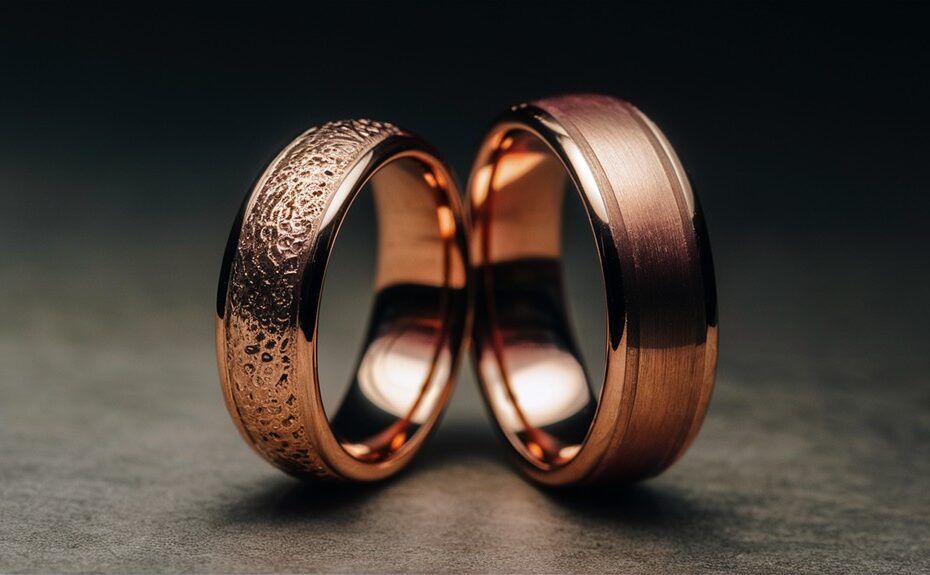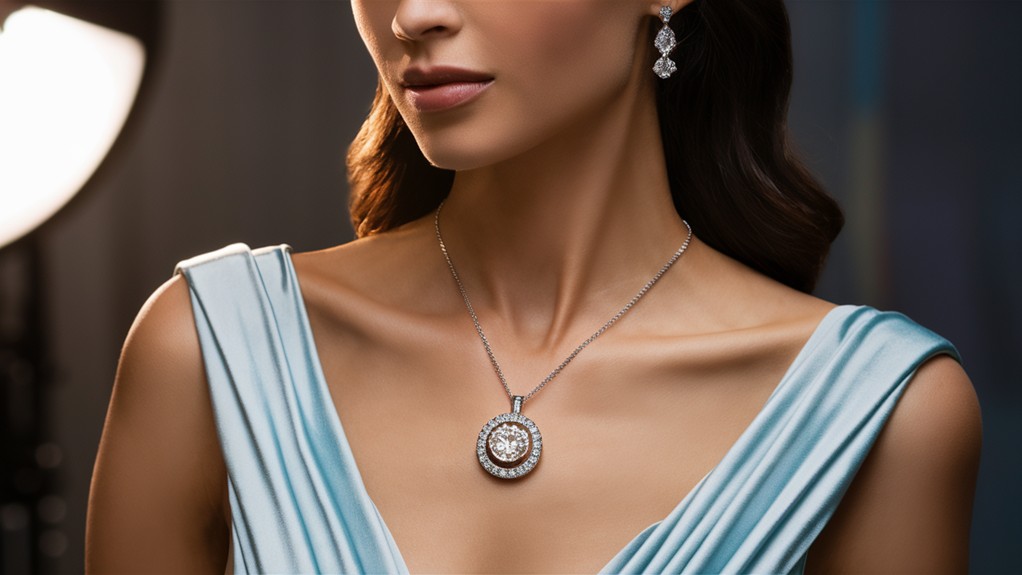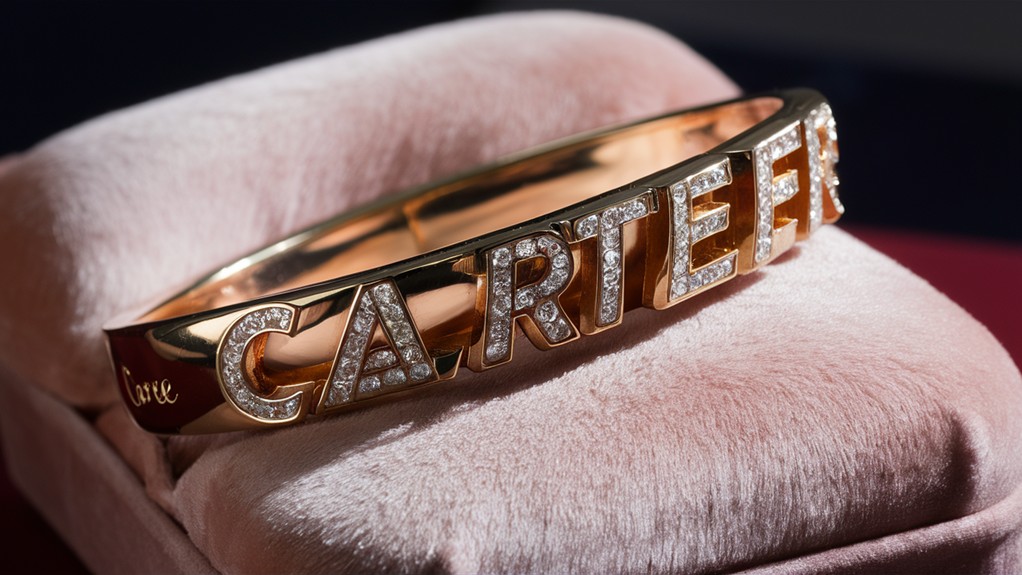When you're considering rose gold jewelry, the karat choice can greatly impact your piece's quality, appearance, and durability. You'll often find yourself deciding between 14K and 18K rose gold, each with its own unique properties. Understanding the differences in purity, composition, and wear characteristics will help you make an informed decision that aligns with your style and lifestyle. As you weigh the pros and cons of each option, you'll realize that the perfect choice isn't always obvious. What factors should you prioritize in your decision, and how will they affect your jewelry in the long run?
Our Highlighted Points
- 14K rose gold contains 58.3% pure gold, while 18K rose gold contains 75% pure gold.
- 14K rose gold is more durable and scratch-resistant, making it suitable for everyday wear.
- 18K rose gold has a richer color and is less likely to cause skin allergies.
- 14K rose gold is more affordable, costing 50-67% less than 18K rose gold.
- The choice between 14K and 18K depends on lifestyle, budget, color preference, and intended use.
Understanding Gold Purity

In relation to rose gold jewelry, understanding gold purity is crucial for making an informed purchase. Gold purity is measured in karats, with 24K representing 100% pure gold. As you investigate rose gold options, you'll encounter two common choices: 14K and 18K gold.
14K gold contains 58.3% pure gold, while 18K gold consists of 75% pure gold. The remaining percentage in both cases is made up of alloy metals, which contribute to the jewelry's durability and color.
Here's what you need to know:
– 18K rose gold:
- Higher gold content (75% pure gold)
- Richer, more vibrant color
- Softer and more prone to scratches
- Less likely to cause skin allergies
– 14K rose gold:
- Lower gold content (58.3% pure gold)
- Slightly lighter color
- More durable and scratch-resistant
- May contain more nickel, increasing allergy risk
When choosing between 14K and 18K rose gold, consider factors such as:
- Your budget
- Desired color intensity
- Durability requirements
- Potential skin sensitivities
Composition of Rose Gold
Now that you're familiar with gold purity, let's investigate the unique composition of rose gold. This precious metal is an alloy primarily consisting of yellow gold combined with copper, which imparts its distinctive pinkish-red hue. The composition varies depending on the karat:
14K Rose Gold:
- Approximately 58.3% pure gold
- 38.3% copper
- Small amounts of silver and zinc
18K Rose Gold:
- About 75% pure gold
- 23% copper
- Trace amounts of other metals
The higher copper content in 14K rose gold results in a more pronounced pink color, while 18K rose gold exhibits a subtler peach tint. In spite of these differences, both 14K and 18K rose gold maintain the same percentage of pure gold as their yellow gold counterparts, ensuring comparable value and durability.
It's worth noting that jewelers can create custom alloys to achieve personalized colors in rose gold jewelry. By adjusting the metal content, particularly the copper percentage, craftsmen can produce varying shades of rose gold to suit individual preferences.
This flexibility allows for a wide range of options in rose gold jewelry design, from soft, subtle hues to bold, vibrant tones.
14K Rose Gold Properties
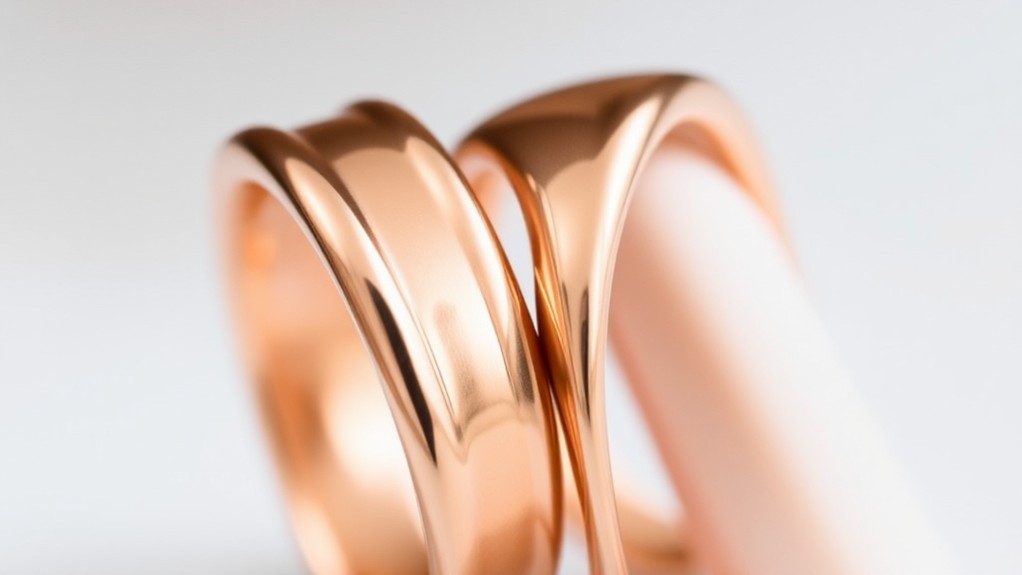
When comparing 14K and 18K rose gold, you'll find distinct differences in their properties. These variations arise from their composition and affect their appearance, durability, and suitability for different uses.
14K rose gold contains approximately 58.3% gold, while 18K rose gold has about 75% gold content. This difference in gold content notably impacts the properties of these alloys:
- Color: 14K rose gold typically has a more pronounced pink hue because of its higher copper content, while 18K rose gold exhibits a subtler, richer shade of pink.
- Durability: The higher alloy content in 14K rose gold makes it generally more durable than 18K, making it better suited for everyday wear and active lifestyles.
- Allergenic potential: 18K rose gold, with its higher gold content, is less likely to cause skin allergies compared to 14K.
- Value: 18K rose gold has a higher inherent value because of its greater gold content.
When choosing between 14K and 18K rose gold, consider your lifestyle, budget, and aesthetic preferences.
If you prioritize durability and a more pronounced pink color, 14K may be the better choice. For a subtler hue and reduced allergy risk, opt for 18K rose gold.
18K Rose Gold Characteristics
Several key characteristics define 18K rose gold, setting it apart from its 14K counterpart. The most notable difference lies in the gold content, with 18K rose gold containing 75% pure gold compared to 14K's 58.3%. This higher purity results in a subtler peach color, while 14K rose gold exhibits a more pronounced pink hue owing to its increased copper content.
When considering durability, 14K rose gold takes the lead. Its lower gold content and higher proportion of harder metals make it more suitable for everyday wear, especially in pieces like engagement rings that endure frequent use.
However, 18K rose gold's higher purity offers its own advantages, including a richer color and potentially higher value.
The alloy composition of both types contributes to their unique color and properties:
- 18K rose gold: 75% gold, 23% copper, 1.3% silver, 0.7% zinc
- 14K rose gold: 58.3% gold, 38.3% copper, 2.1% silver, 1.3% zinc
These distinct rose gold characteristics allow you to choose the ideal option based on your preferences for color intensity, durability, and general quality in your jewelry pieces.
Durability and Wear Comparison
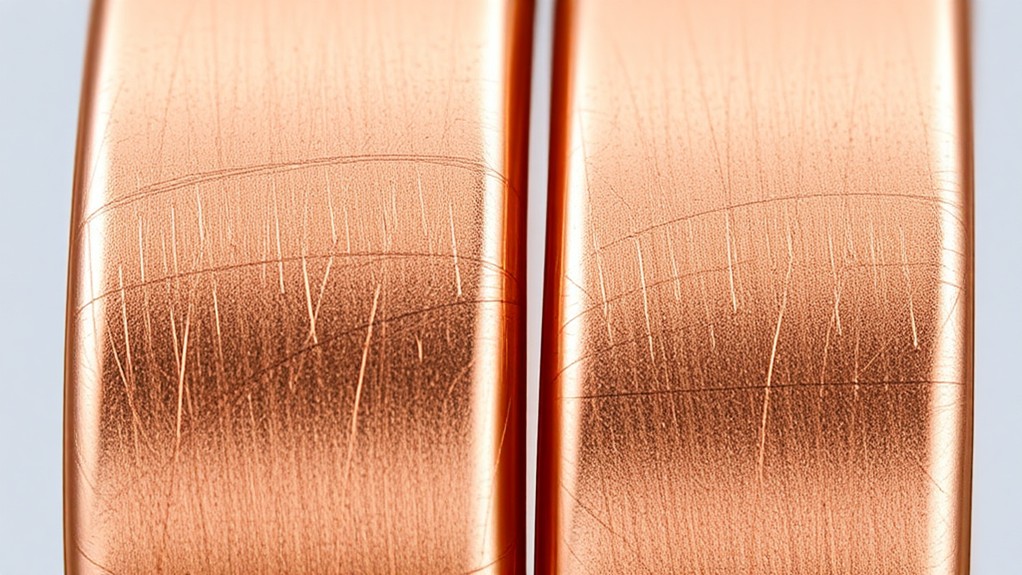
Comparing the durability and wear characteristics of 14K and 18K rose gold reveals significant differences that can impact your jewelry choice.
14K rose gold, with its higher alloy content of 41.7%, stands out as the more durable option. This increased hardness makes it more resistant to scratches and better suited for everyday wear, especially if you lead an active lifestyle.
When considering intricate designs, such as engagement rings, 14K rose gold is often the preferred choice. Its ability to maintain shape and details longer guarantees your jewelry retains its beauty for years to come.
While 18K rose gold offers a more luxurious and vibrant appearance, its softer nature requires more careful handling to avoid damage.
For those seeking a balance between durability and aesthetic appeal, 14K rose gold is the recommended option. It provides:
- Better resistance to daily wear and tear
- Longer-lasting intricate designs
- Reduced need for frequent polishing or repairs
In contrast, 18K rose gold is ideal for special occasions and fine jewelry pieces that aren't subjected to constant use.
When deciding between the two, consider your lifestyle and intended use to guarantee your rose gold jewelry stands the test of time.
Color and Aesthetic Differences
The color and aesthetic differences between 14K and 18K rose gold are striking and often serve as the deciding factor for many jewelry buyers.
14K rose gold boasts a more pronounced pink hue as a result of its higher copper content, making it an eye-catching choice for those who prefer bolder jewelry.
When comparing the two alloys, you'll notice that 18K rose gold contains 75% pure gold, resulting in a subtler peach tone. This higher gold content creates a richer, warmer appearance that closely resembles pure gold.
In contrast, 14K rose gold, with its 58.3% gold composition, exhibits a more vibrant pinkish color because of its increased copper content of 38.3%.
The aesthetic appeal of each karat depends on personal preference and desired color depth. If you're looking for a bold, attention-grabbing piece, 14K rose gold's intense color might be your ideal choice.
However, if you prefer a more elegant and sophisticated look, 18K rose gold's warmer, richer hue could be more suitable.
When selecting between 14K and 18K rose gold, consider:
- Color intensity preference
- Desired aesthetic appeal
- Complementary skin tone
Choosing Between 14K and 18K
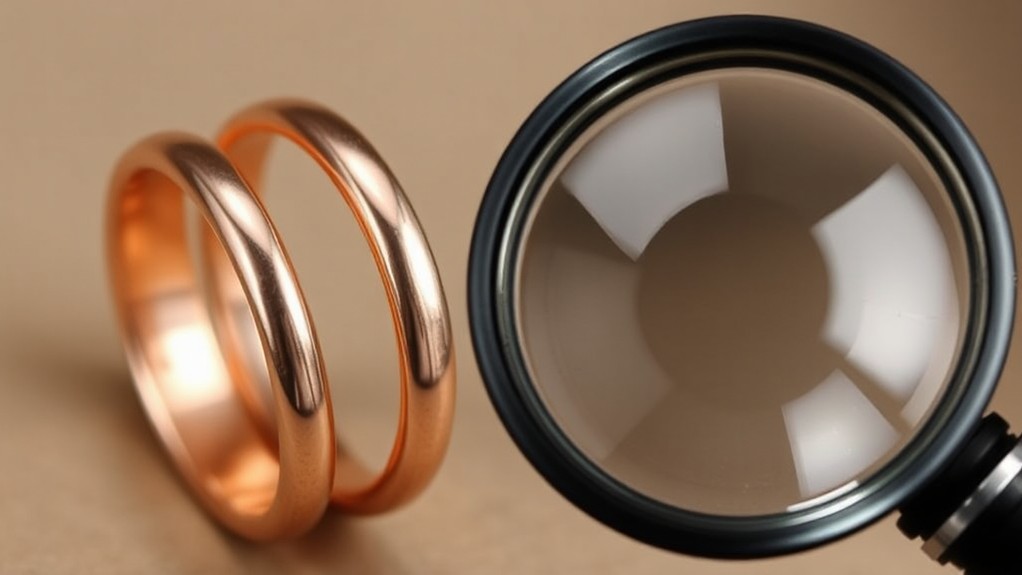
With a clear understanding of the aesthetic differences between 14K and 18K rose gold, you're now ready to make an informed decision.
When choosing between these two options, consider your lifestyle, budget, and preferences. 14K rose gold, with its lower gold purity of 58.3%, offers greater durability and affordability, making it ideal for daily wear and engagement rings. Its alloy composition, containing more copper, results in a more pronounced pink hue. Alternatively, 18K yellow gold, with its higher gold purity of 75%, exudes a richer, more intense yellow color and is more suitable for those with sensitive skin. When comparing rose gold vs yellow gold, it ultimately comes down to personal preference and which properties are more important to you. Whether you prioritize durability, color, or skin sensitivity, both options have their own unique charm and appeal.
On the other hand, 18K rose gold boasts a higher gold purity of 75%, providing a luxurious appearance and hypoallergenic properties. However, it's softer and more prone to scratches, making it better suited for special occasions or fine jewelry.
When comparing prices, 14K rose gold is considerably more budget-friendly, costing up to 50-67% less than its 18K counterpart.
Consider these factors when making your decision:
- Your lifestyle and activity level
- Desired color intensity
- Budget constraints
- Skin sensitivity and potential allergies
- Intended use (daily wear vs. special occasions)
Ultimately, your choice between 14K and 18K rose gold depends on balancing these factors with your personal preferences and needs.
Both options offer unique benefits, ensuring you'll find the perfect rose gold piece for your jewelry collection.
Frequently Asked Questions
Is 14K Rose Gold Better Than 18K?
Whether 14K or 18K rose gold is better depends on your priorities. If you're looking for durability and affordability, 14K is your best bet. However, if you value purity and hypoallergenic properties, 18K is the superior choice.
What Carat Rose Gold Is Best?
The best carat rose gold depends on your priorities. If you're after durability and affordability, 14K is ideal. For a richer color and fewer allergies, 18K is better. Consider your lifestyle and budget when choosing.
Can You Visually Tell the Difference Between 14K and 18K Gold?
You can often visually distinguish between 14k and 18k gold. You'll notice 18k has a richer, deeper color because of its higher gold content. Under good lighting, you'll see 18k's warmer tones compared to 14k's lighter hue.
What Is the Highest Grade of Rose Gold?
You'll find that 24K is the highest grade of rose gold, containing 100% pure gold. However, it's rarely used in jewelry because of its softness. Instead, you'll typically see 18K or 14K rose gold in most pieces.
